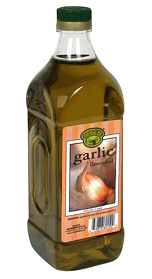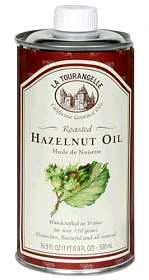

Flaxseed oil has such a high level of omega-3 fatty acids that many people take it in supplement capsules. However, it does just as well in a salad! Photo © Elena Schweitzer | Fotolia.
November 2006
Last Updated October 2012
|
 |
Type Of Cooking Oil Glossary
Page 3: Types Of Cooking Oil ~ E To K
Looking for a different type of cooking oil? This is Page 3 of a six-page glossary of cooking oil types. Click on the black links below to visit other pages. See our other delicious food glossaries.
 EXTRA VIRGIN EXTRA VIRGIN
When used to describe refined oils, as opposed to olive oils, this refers to an oil that has been pressed as opposed to refined.
FINISHING OIL
A high-quality oil with special flavors, used as a condiment. See anointing oil.
FLAVORED OIL
Generally, an oil that has been infused with another flavor. Typically, these are fruits, herbs and spices. Popular flavors are basil, chile, garlic, lemon, oregano and rosemary. See infused oil.
FLAXSEED OIL
A smooth, buttery oil cold-pressed from the seeds of the flax plant. The flavor makes it appropriate as a salad oil; however, since the oil has a very high level of omega-3 fatty acids*, it is most often used as a nutritional supplement rather as a culinary oil. By the way, if the seeds are hot pressed, they produce linseed oil, an industrial oil and solvent which is not edible. See photo top left.
*A polyunsaturated fat considered to be helpful in reducing potential stroke and heart disease problems.
GRAPESEED OIL
Grapeseed oil is pressed from the grape seeds left over from wine making. The oil is almost tasteless, so it can be combined with stronger-flavored, more expensive oils, which makes them more economical to use. Refined grapeseed oil has a high smoke point so it is an excellent choice as a cooking oil, especially when sautéing or frying. Grapeseed oil is also used by commercial producers of mayonnaise. Not to be confused with rapeseed (canola) oil.
 HAZELNUT OIL HAZELNUT OIL
Hazelnut oil is a brown-colored oil with a strong, roasted hazelnut flavor. It is generally used as a flavoring for baked goods, in salad dressings, marinades and for some sauces. It is delicious drizzled on fish, poultry and pork products. See nut oils.
HEAT EXTRACTION or REFINING
One of the two methods for extracting oil. Heat extraction methods include expeller pressing and solvent extraction. The highly refined heat extracted oils usually lack color and flavor, but have a higher smoke point and longer shelf life than oils obtained through cold extraction. See also cold extraction.
INFUSED OIL
Infusion is a method of flavor extraction that incorporates the flavor of herbs or fruits into oil by steeping and removing. See also flavored oil.
Continue To Page 4: Terms From L To O
Go To The Article Index Above
|





 EXTRA VIRGIN
EXTRA VIRGIN 